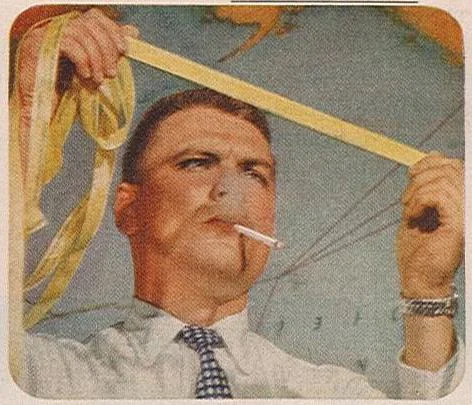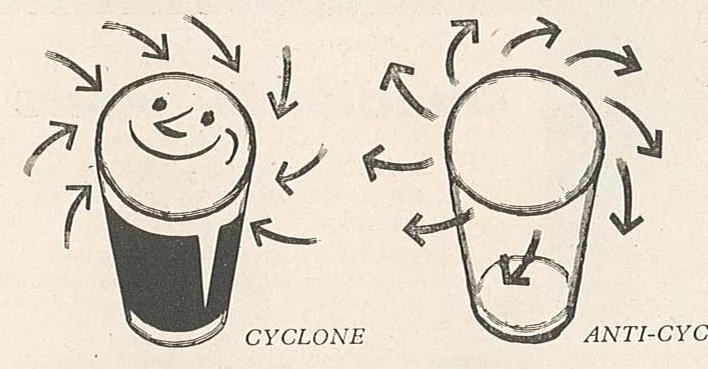Men of America: Hurricane Alert, 1958
Gale wind rages, foaming breakers roar!
Radar warning, storm will hit our shore!
Checking on the weather you’ll find a man…
Stops and takes big pleasure when and where he can… CHESTERFIELD!
Sometimes bad poetry can illustrate big changes in cultural attitudes towards science.
“Not too long ago the weatherman was caricatured as an ineffectual, bearded, finger–wetting and preoccupied sky gazer,” wrote the former weather cadet and sometime TV meteorologist Frank Forrester in 1957. But scientific progress had changed the meaning of meteorology. “Today’s weather man is much more impressive. He is part of a complex corps of specialists who are constantly laboring to expand and apply their science. Industries and armies have come to rely upon him for guidance in their planning.”
Cartoons like this one from 1940 illustrate how the image of meteorologists was changing as a result of their association with industry and the military. The wizardly meteorologist is still represented as a bearded and pre-occupied sky gazer, but also a person that pilots should learn from. Cartoon drawn by Bo Brown, in “Sparring with the Weather,” by Robert N. Buck (booklet published by Aero Insurance Underwriters, 1940): p. 21. Author’s personal collection.
Americans began to picture meteorology in new ways during the 1950s. Weather forecasting was increasingly represented as a manly and even heroic activity. As the Chesterfield cigarette ad suggests, clean cut and rugged male meteorologists would protect “our” land from the raging gales. And since the Weather Bureau had recently started naming hurricanes after women, the implication was clear: scientific men could keep Americans safe from a dangerous and feminine Mother Nature.
Masculinity has recently become a significant topic in the history of science. Historians have described how the meanings of manliness change over time, and can differ from culture to culture. We see masculinity as a social construction that emerges through performance—the ways that people act and react—and through representations like this advertisement. Chesterfield was simultaneously selling cigarettes and recruiting a particular type of person into meteorology.
We know that the image of the heroic masculine meteorologist ascended as women were being actively pushed out of meteorology. But as Erika Milam and Robert Nye point out, representations of masculinity can serve both as a foil for femininity, and as a way to sort out different types of men. How did the manly defender image affect male meteorologists who did not fit this stereotype? That’s a question that awaits an answer.
Learn More
- Frank H. Forrester, 1001 Questions Answered About the Weather (Dodd, Mead and Co, 1957).
- Roger Turner, “Keeping Meteorology Masculine: The American Meteorological Society’s Response to Television ‘Weather Girls’ in the 1950s,” in Weather, Local Knowledge and Everyday Life: Issues in Integrated Climate Studies, Edited by Vladimir Jankovic and Christina Barboza (MAST, 2009): 147-158.
- Erika Lorraine Milam and Robert A. Nye, “An Introduction to Scientific Masculinities,” Osiris 30 (2015): 1-14.







